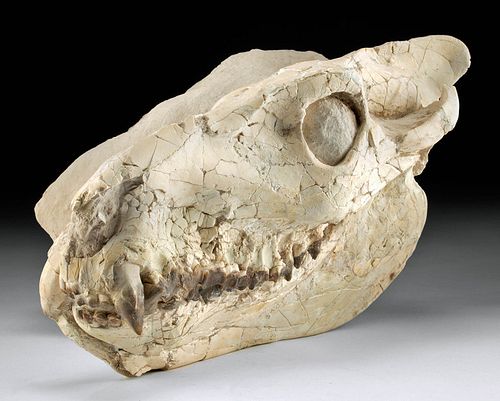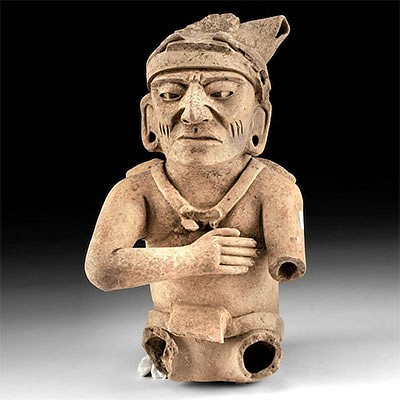Large Fossilized North American Oreodont Skull
Lot 102
About Seller
Artemis Fine Arts
686 S Taylor Ave, Ste 106
Louisville, CO 80027
United States
Selling antiquities, ancient and ethnographic art online since 1993, Artemis Gallery specializes in Classical Antiquities (Egyptian, Greek, Roman, Near Eastern), Asian, Pre-Columbian, African / Tribal / Oceanographic art. Our extensive inventory includes pottery, stone, metal, wood, glass and textil...Read more
Categories
Estimate:
$2,400 - $3,600
Absentee vs Live bid
Two ways to bid:
- Leave a max absentee bid and the platform will bid on your behalf up to your maximum bid during the live auction.
- Bid live during the auction and your bids will be submitted real-time to the auctioneer.
Bid Increments
| Price | Bid Increment |
|---|---|
| $0 | $25 |
| $300 | $50 |
| $1,000 | $100 |
| $2,000 | $250 |
| $5,000 | $500 |
| $10,000 | $1,000 |
| $20,000 | $2,500 |
| $50,000 | $5,000 |
| $100,000 | $10,000 |
| $200,000 | $20,000 |
About Auction
By Artemis Fine Arts
Feb 3, 2022
Set Reminder
2022-02-03 10:00:00
2022-02-03 10:00:00
America/New_York
Bidsquare
Bidsquare : VARIETY SALE | Ancient, Asian, Ethnographic
https://www.bidsquare.com/auctions/artemis-gallery/variety-sale-ancient-asian-ethnographic-8833
Join us for our first sale of February with a spotlight on two fabulous collections, one from Lumberton, Texas, and the other from Whisnant Gallery in New Orleans. Artemis Fine Arts info@artemisgallery.com
Join us for our first sale of February with a spotlight on two fabulous collections, one from Lumberton, Texas, and the other from Whisnant Gallery in New Orleans. Artemis Fine Arts info@artemisgallery.com
- Lot Description
North America, Western United States, likely Wyoming, White River Formation, late Eocene to early Miocene period, ca. 46 to 16 million years ago. A fossilized skull from an oreodont (Merycoidodon), a prehistoric mammal that roamed across North America. This skull is beautifully preserved with white plaster on the interior cavities and a large stone matrix that acts as a support base. The visible orbit (ocular cavity) is mostly intact as is the zygomatic arch. The upper and lower jaws are slightly parted to reveal the rows of teeth, from which the oreodont name is derived. The molar teeth are an interesting high crown shape - pointy and triangular, and their name translates to "mountain tooth." The front canines are sharp like a predator; however, these mammals were herbivores and had traits that often were described as sheep, rhino, or pig like- although they may be more closely related to camelids. There are many different species that fall under the oreodont family, and this skull comes from a larger member of this extinct mammal. Size: 14" L x 8" W x 10" H (35.6 cm x 20.3 cm x 25.4 cm)
Provenance: private Lumberton, Texas, USA collection, acquired before 2010
All items legal to buy/sell under U.S. Statute covering cultural patrimony Code 2600, CHAPTER 14, and are guaranteed to be as described or your money back.
A Certificate of Authenticity will accompany all winning bids.
PLEASE NOTE: Due to recent increases of shipments being seized by Australian & German customs (even for items with pre-UNESCO provenance), we will no longer ship most antiquities and ancient Chinese art to Australia & Germany. For categories of items that are acceptable to ship to Australia or Germany, please contact us directly or work with your local customs brokerage firm.
Display stands not described as included/custom in the item description are for photography purposes only and will not be included with the item upon shipping.
#169314Professionally prepared and restored with visible break lines, fissures, and infill. Approximately 70% original material. Half of lower mandible is new material and care has been taken to preserve original structure but may deviate slightly from actual shape. Chips throughout and losses to temporal area and vomer (nasal bone). Some teeth are reattached, including the upper canines. Half of skull is embedded in a stone matrix as shown, which creates a natural base.Condition
- Shipping Info
-
All shipping is handled in-house for your convenience. Your invoice from Artemis Gallery will include shipping calculation instructions. If in doubt, please inquire BEFORE bidding for estimated shipping costs for individual items.
-
- Buyer's Premium



 EUR
EUR CAD
CAD AUD
AUD GBP
GBP MXN
MXN HKD
HKD CNY
CNY MYR
MYR SEK
SEK SGD
SGD CHF
CHF THB
THB















